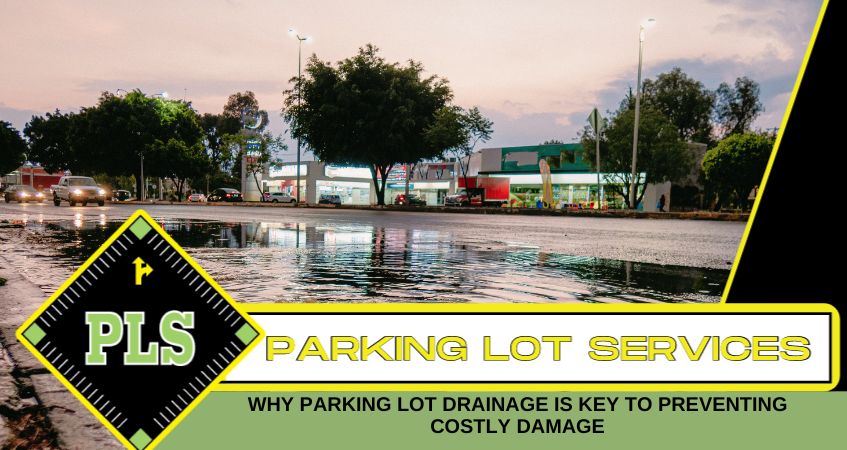If you own or manage a parking lot, effective parking lot drainage isn’t just a maintenance detail… It’s a critical safeguard against flooding, structural damage, safety hazards, and expensive repairs. Poor drainage can cause water to collect on your pavement, leading to premature deterioration, cracks, potholes, and even foundation issues. A proactive approach to proper drainage will help protect your property investment, ensure safety for users, and keep repair costs to a minimum.
The Importance of Parking Lot Drainage
Parking lot drainage is not just about removing visible puddles – it’s about channeling water away from your lot to prevent both immediate and long-term damage. When stormwater or rain isn’t directed properly, standing water can seep into the pavement, softening and weakening it. Over time, this can cause:
Surface cracks and potholes
Base layer erosion
Sinkholes or uneven surfaces
Hazardous, slippery conditions for drivers and pedestrians
More than just aesthetic issues, these hazards can create liability risks, lead to costly repairs, and interrupt business operations.
Risks and Costs of Poor Drainage
Ignoring drainage issues can lead to:
Flooding that damages vehicles and property
Accelerated pavement deterioration, resulting in frequent and expensive repairs
Slip-and-fall accidents from standing water or ice patches
Mold and mildew under the surface, weakening your lot’s foundation
Here’s a breakdown of the costs poor drainage can cause:
Surface Repairs: Water undermines asphalt and concrete, leading to cracks and potholes.
Base Repairs: Persistent moisture weakens the materials below, often requiring full-depth replacement.
Liability Expenses: Accidents due to water pooling or ice formation can result in injury claims.
Business Disruption: Flooded lots turn customers away and cause service interruptions.
How Proper Drainage Protects Your Parking Lot
Investing in quality drainage systems and a routine parking lot maintenance plan brings several benefits:
Extends Pavement Life: Minimizes freeze-thaw cycles and water penetration, reducing cracks.
Improves Safety: Dry surfaces reduce accident risks for vehicles and pedestrians.
Saves Money: Prevents the need for frequent, costly repairs.
Maintains Curb Appeal and Value: No big puddles or unsightly damage to detract from your property.
Quality drainage solutions incorporate:
Properly sloped surfaces
Effective trench and catch basin drains
Regular inspection and cleaning of drainage features
Signs Your Parking Lot Needs Drainage Improvements
Don’t wait for a major issue to appear. Look for these warning signs that your parking lot’s drainage needs attention:
Water pooling that doesn’t drain after rainstorms
Persistent puddles in the same spots
Visible cracks, potholes, or surface ruptures
Uneven surfaces or settling in the pavement
Accumulated dirt or debris around drains
Addressing these symptoms early can prevent major costly repairs down the road.
Best Practices for Parking Lot Maintenance and Drainage Systems
Regular maintenance and professional assessments are essential to keep your parking lot drains functioning well. Here’s how to stay ahead:
Schedule routine inspections – especially after heavy rain
Remove debris from catch basins, inlets, and surface grates
Repair cracks and holes promptly to block water infiltration
Re-grade surfaces or adjust slopes where water pools
Install or upgrade drains in problem areas
A combination of diligent parking lot maintenance and modern drainage solutions will help you avoid flooding, prolong the life of your lot, and minimize emergencies.
Frequently Asked Questions (FAQs)
1. How often should commercial parking lot drains be cleaned or inspected?
Most experts recommend at least biannual inspections, especially before and after winter, to ensure drains are debris-free and functioning.
2. What type of drainage system is best for my parking lot?
The best system depends on your lot’s size, slope, and location. Common solutions include catch basins, trench drains, and properly sloped surfaces. A professional assessment will identify the ideal approach.
3. Can I fix poor drainage myself, or do I need a professional?
Basic maintenance like removing surface debris is doable, but significant drainage problems should be evaluated by experienced contractors to avoid recurring issues or regulatory problems.
4. What signs indicate immediate drainage issues needing urgent attention?
Large or persistent puddles, rapid appearance of potholes, surface heaving, and blocked drains are urgent signals – they require prompt action to prevent deeper damage.
5. Does insurance cover repairs related to flooding or drainage failure?
Insurance coverage varies. Some policies may exclude gradual damage or issues caused by improper maintenance. Proper drainage can help avoid uncovered repair costs.
Call PLS to Schedule Your Free Drainage Evaluation
Don’t let poor drainage damage your investment or put your customers at risk. Contact PLS (Parking Lot Services) today at (813) 880-9100 to request your free drainage evaluation.
Our team specializes in expert parking lot drainage solutions designed to withstand Florida’s heavy storms and protect your property for years to come.

